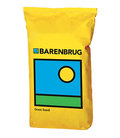1. Beware a false sense of security
After a period of rainfall, lower-lying areas and perennial grasses (fescues, bents and ryegrass) will begin to green up and require mowing once more. However, high spots and areas colonised with the shallow-rooted weed grass Poa annua are likely to be weakened or at worst dead. If left alone, the bare areas will become green again, but do not mistake this for “recovery”. The new vegetation will most likely arise from new wind-blown Poa annua seeds, or worse, moss and other weeds. This is only a short-term fix and one that compromises playability and aesthetics.
2. What to do about it (and the hidden opportunity)
In dead areas, now is the time to act. Use this as an opportunity to establish drought-tolerant perennial turfgrasses, to prevent problems happening again. Scarify and remove dead material as quickly as possible and overseed with a specialist mixture. Overseeding into an old, matted surface will not create favourable conditions for gemination, therefore it is crucial that significant thatch issues are addressed first. Hollow-coring may be appropriate in worst-affected areas. Do not sit back and wait for weeds to colonise; this is a race against time to get seedlings established before Winter. Overseeding with so much space for seedlings to grow (versus a wet Summer with a tight sward), is going to be a lot easier for healthy, robust grass to establish.
3. Convincing committees to invest
Turf managers understand this is an obvious course of action, but convincing committees that overseeding large areas can be challenging. If budgets are prohibitive, target one or two really bad fairways and overseed these at an appropriate rate. This is a better strategy than spreading your efforts too thinly. Document the project and use it to your advantage the next time the issue arises. Under a range of stress factors, these areas will demonstrate what can be achieved with investment. For example, ryegrass on tees and fairways will offer improved drainage in wet conditions over Poa thanks to increased root structure and less thatch build-up.
4. Save now, pay later
If annual meadowgrass establishes between now and Autumn, and we get a harsh Winter, it will undoubtedly quickly die back again. Re-turfing before next playing season may be your only solution in this case. Overseeding now with a hardy mixture may well save your club having to pay for more expensive repairs later.
5. Another drought doesn’t have to mean disaster
This Summer we’ve seen lots of customers seeing the benefits of previous overseeding investment. That’s because bents, fescues and ryegrass are far more tolerant than annual meadowgrass and will recover quickly after drought. With so many courses struggling to maintain playability in this heat, now is the time to act.








